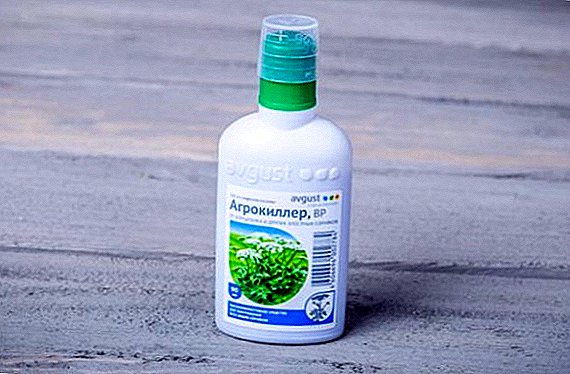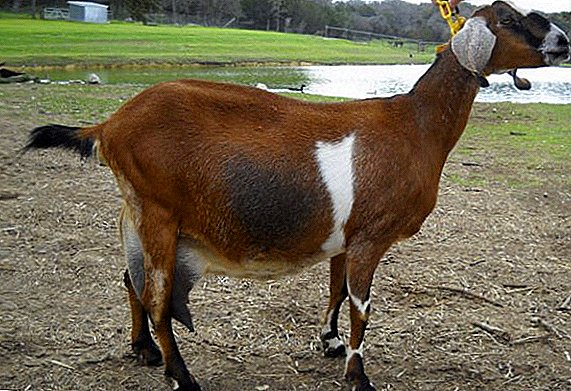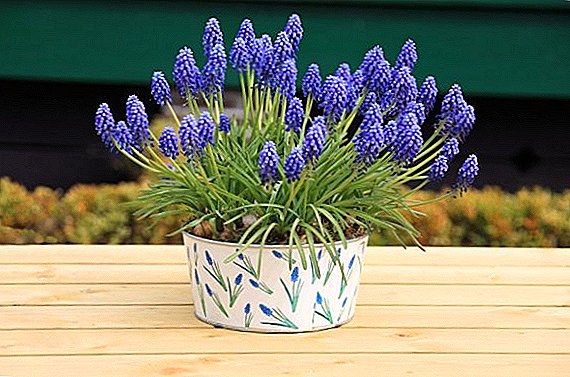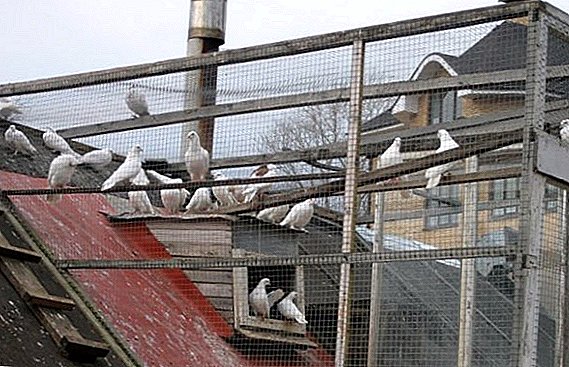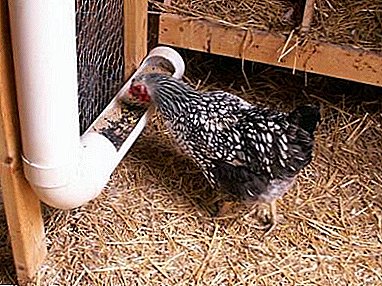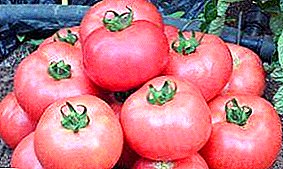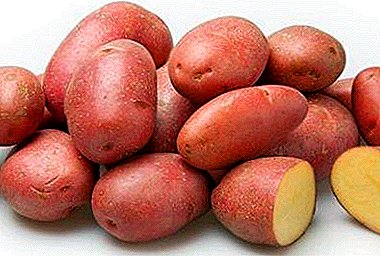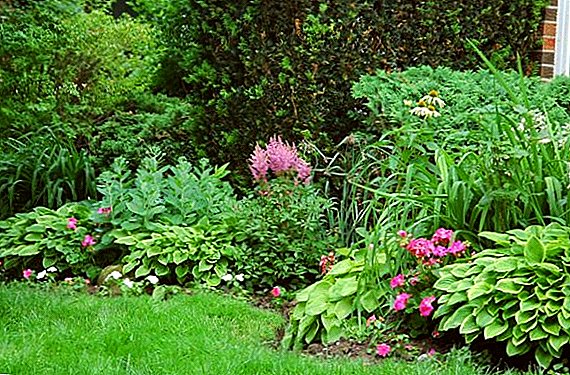 At any summer cottage there are places that are constantly in the shadows, behind the house, the garage or under the fruit trees. Often gardeners ask how to ensure that these territories do not gape black holes of black earth, but are pleasing to the eye with variegated colors. And then the problem arises, since most flowers and ornamental plants still prefer to grow under the sunlight. However, there are a number of shade plants to give, after planting which you can create beautiful flower arrangements. In this article, we are introduced to decorative perennials, who prefer to grow in the shade.
At any summer cottage there are places that are constantly in the shadows, behind the house, the garage or under the fruit trees. Often gardeners ask how to ensure that these territories do not gape black holes of black earth, but are pleasing to the eye with variegated colors. And then the problem arises, since most flowers and ornamental plants still prefer to grow under the sunlight. However, there are a number of shade plants to give, after planting which you can create beautiful flower arrangements. In this article, we are introduced to decorative perennials, who prefer to grow in the shade.
Important! Before planting at the dacha, it is advisable to investigate the dacha site for the presence of shade in a given period of the day and highlight the following categories: 1) areas with constant shading throughout the day; 2) areas with partial shading (only during a certain period of the day); 3) plots with scattered (sparse) shade (from other higher plants).
Astilba
If you are only looking for information about which garden flowers are suitable for partial shade, we recommend you look at Astilbe. This herbaceous plant of the stone-sawing family combines 40 species and over 400 varieties. It grows from 15 cm to 2 meters. It blooms in June-August with panicle inflorescences of red, white, pink, purple flowers. It has large leaves that form a lush openwork bush. Lives an average of five years.  Growing conditions. Prefers a scattered shadow. It grows well on any soil, but long-term flowering can be achieved by planting astilba in the ground with a close location of groundwater. Unpretentious care. Loves good watering. She tolerates winter well, only sudden changes in temperature can be fatal for her.
Growing conditions. Prefers a scattered shadow. It grows well on any soil, but long-term flowering can be achieved by planting astilba in the ground with a close location of groundwater. Unpretentious care. Loves good watering. She tolerates winter well, only sudden changes in temperature can be fatal for her.
Breeding methods. Propagated by seed, dividing the bush and shoots.
Application. It is well combined with bergenia, irises, lily of the valley, podofillum, hellebore. It is used in mixed flower beds, on stony hills, in ridges.
Aconite (wrestler)
In the overview of the plants for the penumbra can not do without aconite (Acónítum). This is a perennial herbaceous flowering plant of the buttercup family with a stem height of 50-150 cm. It includes several dozen varieties. It blooms from July to late October with raceme shaped inflorescences of blue, white, purple, yellow. The plant is considered poisonous because it contains alkaloids. 
Did you know? About the toxic properties of aconite has been known for a long time. Different nations used it to poison predators and enemies, poison for arrows and spears.
Growing conditions. It grows in moist places in soils rich in humus. However, it can also tolerate different soils, except sandy and stone. Does not like stagnant moisture, strong waterlogging can ruin a flower. Feels good in the shade and in partial shade. Does not require special care activities. Frost resistant
Breeding methods. Propagated in several ways: seed, bush division, tubers, cuttings.
Application. Looks impressive next door to peonies, astilbe, irises, rudbeckia. Used for mixed flower beds, flower beds, and for wall decoration, it can serve as a screen to cover an unattractive building or an outbuilding.
Brunner
You can not ignore even one more flowers for shady places - Brunner (Brunnera). This perennial plant of the borage family with beautiful large leaves and non-forgetful flowers in the inflorescences is rightly called the longevity, since it can live up to 10-15 years. It grows sprawling bush, reaches a height of 40 cm. It blooms in May. Beautiful from the end of April to the first frost. In culture, there are two kinds.  Growing conditions. Grows on clay, wet soils. You should not plant this plant in full shade - in this case it will lose its decorative effect: the stems will stretch. When planting it in the sun should provide abundant regular watering. Brunner is easy to maintain. The plant is very frost-resistant - withstands temperatures up to -29 ºС.
Growing conditions. Grows on clay, wet soils. You should not plant this plant in full shade - in this case it will lose its decorative effect: the stems will stretch. When planting it in the sun should provide abundant regular watering. Brunner is easy to maintain. The plant is very frost-resistant - withstands temperatures up to -29 ºС.
Breeding methods. Propagated by dividing rhizomes, root processes, seeds.
Application. Its partners in mixborder can be the hellebore, primrose, female fern. Brunner also planted in borders.
Dicentra
The list of shade-tolerant perennials also includes a dicotra (Dicentra) - a herbaceous plant that attracts attention with its heart-shaped flowers. Another name for Dicentres - "broken heart" - comes from the legend of the unfortunate love of the French girl Jeanette. Perennial has about 20 species. The height of the flower varies from 30 cm to 1.5 m. The flowering period is May-June, the flowering time is about a month. The flowers are bright pink or white in drooping arched inflorescences. The leaves are green with a bluish tint, give beauty to the plant even before flowering. "Broken heart" has a high immunity to pests and diseases. The flower is frost-resistant, but requires shelter for the winter.  Growing conditions. It grows well on moist soils with drainage and with a sufficient amount of humus. It can be planted both in a sunny area and in the shade of trees, but it blooms earlier in the sun. It requires good watering, regular loosening of the earth for access of oxygen to the roots and weeding. It is also necessary to remove wilted flowers in time.
Growing conditions. It grows well on moist soils with drainage and with a sufficient amount of humus. It can be planted both in a sunny area and in the shade of trees, but it blooms earlier in the sun. It requires good watering, regular loosening of the earth for access of oxygen to the roots and weeding. It is also necessary to remove wilted flowers in time.
Breeding methods. Propagated by dividing the bush, root cuttings, at least - seed method.
Application. It forms interesting flower arrangements with daffodils, hyacinths, tulips, brunner, and stone-cutlets. Used in mixborders, on the alpine hill.
Doronicum
Light shading loves Doronicum (Doronicum) - a perennial of the Aster family. The genus includes 36 species. Blooms large yellow flowers, shaped like a chamomile. Flowering occurs in May, lasts about a month. Grows rapidly, forming a lush bright bushes. Differs in high frost resistance. The recommended duration of growth in one place is three to four years.  Growing conditions. When planting doronicum should be borne in mind that it tolerates only partial shade, in absolute shadow completely loses its decorative effect. It becomes unattractive after flowering.
Growing conditions. When planting doronicum should be borne in mind that it tolerates only partial shade, in absolute shadow completely loses its decorative effect. It becomes unattractive after flowering.
Important! When planting, you need to clearly understand the importance of agrotechnical requirements for illumination: what is full sun, partial shade, shadow and sparse shadow for plants. "Full sun" means the plant is more than three hours. in a day under direct rays; "penumbra" - about three hours in direct rays in the morning or in the evening, with a shadow in the middle of the day, or good illumination without direct rays throughout the day; “shadow, shady zones, full shadow” - three hours of direct daylight in the middle of the day and limited illumination throughout the rest of the time; "Sparse shadow" - partial penetration of sunlight during the day (for example, through the crowns of trees).
Doronicum likes well-drained soil and abundant moisture. Blooms longer on light, loose, slightly acidic, fertile soil. Feels good with moderate and uniform watering.
Breeding methods. Propagated by dividing the bush and seeds.
Application. Doronicum belongs to the plants of the second plan. It should be planted in the company with plants that have a long period of preservation of decorative, for example, with aquilegia, host, rogersiya. Also combined with daffodils, tulips, irises. In landscape design it is planted in mixborders, rockeries, rock gardens.
Volzhanka
Volzhanka (Aruncus) always attracts attention to itself - first of all, by the size of its sprawling bushes, abundant blooming of white inflorescences-panicles and delicate aroma. Arunkus stems can reach a height of up to 2 m. Duration of flowering - two months: June-July. At one place can grow for 15-20 years.  Growing conditions. Volzhanka can equally grow both in open areas and in the shade. However, under direct sunlight the bushes grow poorly. For planting arunku pick up light wet soil with good drainage. The plant is very unpretentious, needs minimal care: regular watering and pruning of flowering inflorescences. Resistant to cold weather (requires shelter for the winter), diseases and weeds.
Growing conditions. Volzhanka can equally grow both in open areas and in the shade. However, under direct sunlight the bushes grow poorly. For planting arunku pick up light wet soil with good drainage. The plant is very unpretentious, needs minimal care: regular watering and pruning of flowering inflorescences. Resistant to cold weather (requires shelter for the winter), diseases and weeds.
Breeding methods. The division of the bush, green cuttings, seeds.
Application. The flower looks beautiful both singly and in groups. Usually, Volzhanka is planted next to low-growing plants. She looks good with astilbe, hosts, Spireas, barberry, barns. It is very good to hide unsightly buildings behind the magnificent arunkus bushes.
Sponge
An excellent plant for a garden in the shade is a sponge (Mimulus). In the homeland of the mimulus - in America - another name for this flower is common: monkey flowers (monkey flowers), due to some similarity of the flowers of the plant on the face of a monkey. The genus of gubastik includes 150 species. The plant stems grow to 60 cm. Depending on the species, they may be different in shape. Coloring of flowers - monophonic or leopard. It has two flowering periods - in spring and autumn.  Growing conditions. Mimulius should be planted in lightly shaded areas in fertile, loose and moist soil rich in peat and humus. Pinning is recommended.
Growing conditions. Mimulius should be planted in lightly shaded areas in fertile, loose and moist soil rich in peat and humus. Pinning is recommended.
Breeding methods. Propagated by cuttings and seeds.
Application. Used in a frame of borders, stony hills, mixborders with lobelia, phlox. Some species are suitable for planting in windows and balcony boxes.
Saxifrage
If you want to cover the shady areas of the carpet of flowers, then you will suit saxifrage (Saxifraga). It is a groundcover from the family of stone-heel plants, numbering 250 species. Stems of saxifrage reach a height of 5 to 70 cm. They are annual, perennial shoots. Flowers - small: 1.5-2 cm in diameter. The color is diverse: white, pink, red, and others. The flowering period begins in May, lasts about a month.
Did you know? The Latin name of saxifrage comes from the words "saxym" and "frango", which are translated as "rock" and "break." This is explained by the fact that in nature this plant is most often found in the crevices of rocks.
 Growing conditions. Planting, growing and caring for stonefriars will not cause difficulties. The very name of the plant itself says that it is not demanding on soil and watering, can grow on poor soils (always with good drainage) and does not like overmoistening. Does not tolerate direct sunlight and dislikes the full shadow (may affect the decorative leaves). It is characterized by high winter hardiness. Young plants require shelter in the winter.
Growing conditions. Planting, growing and caring for stonefriars will not cause difficulties. The very name of the plant itself says that it is not demanding on soil and watering, can grow on poor soils (always with good drainage) and does not like overmoistening. Does not tolerate direct sunlight and dislikes the full shadow (may affect the decorative leaves). It is characterized by high winter hardiness. Young plants require shelter in the winter.Breeding methods. Propagated by seeds, division of the bush, rosettes.
Application. In decorative culture, stoneframes are planted between stones, on slopes, artificial rocks, in rock gardens.
Swimsuit
One of the most unpretentious perennials for the penumbra is the bathing suit (Trollius). In addition to its unpretentiousness, it attracts the attention of gardeners with large bright yellow and orange flowers. The genus of bathing suits includes 20 species. The plant stems grow to 90 cm. It blooms for about 20 days, starting in May. At one place bathing can decorate the garden for 10 years.  Growing conditions. The "flower of the troll" (also called the swimsuit) can grow both in the sun and in partial shade, although in the latter case it loses its decorative effect and loses in growth. For planting suitable fertile wet earth. Although it can grow in poor soil. The only thing that the bathing house does not like is the stagnation of the groundwater. May winter without shelter.
Growing conditions. The "flower of the troll" (also called the swimsuit) can grow both in the sun and in partial shade, although in the latter case it loses its decorative effect and loses in growth. For planting suitable fertile wet earth. Although it can grow in poor soil. The only thing that the bathing house does not like is the stagnation of the groundwater. May winter without shelter.
Breeding methods. You can multiply the bathing vessel by dividing the mother liquor, sowing seeds.
Application. A beautiful neighborhood is obtained from the bathing pool and the catchment, muscari, delphinium, woodland, magnolia, bells.
Lily of the valley
The well-known lily of the valley (Lilium convallium) is also suitable for planting in the shade. This low plant (20-25 cm in height) with dazzling white small flowers in the form of bells and delicate aroma delight their owners in May and June. Leaves remain green until July.
Did you know? Wild lily of the valley is listed in the Red Book.
Growing conditions. The flower loves a moist, organic-rich soil. It grows well in the shade of neighboring trees or bushes. In full shade stops flowering. Does not require care, with proper planting can grow by itself over several years. 
Important! When working with lilies of the valley, it is necessary to protect the hands with gloves, since all the organs of the plant are poisonous.
Breeding methods. Propagated by division of rhizomes and very rarely seeds.
Application. Plant the lily next to the aquilegia, fern, lungwort and you will get a beautiful tender flowerbed. This flower is also used as a groundcover and for forcing.
Lupine
In early summer, in the garden you can admire the flowering of bright perennial lupine candle brushes (Lupinus). This plant belongs to the legume family. People call him wolf beans, because his name comes from the word lupus - wolf. The inflorescences of some species of lupine can reach sizes of 1 m, and the plant itself grows from 50 to 150 cm. The flowers come in various colors: red, white, yellow, violet, pink, blue; there are tricolor. The period of life is five to six years.  Growing conditions. The flower is very drought-resistant - its wild counterparts grow even in deserts. It can grow both in the sun and in partial shade or under diffused lighting. The soil for its landing should be loamy or sandy with low or neutral acidity. Does not cause special difficulties in leaving. Periodic loosening of the soil and removal of weeds is desirable. In winter, bushes should be spud and covered.
Growing conditions. The flower is very drought-resistant - its wild counterparts grow even in deserts. It can grow both in the sun and in partial shade or under diffused lighting. The soil for its landing should be loamy or sandy with low or neutral acidity. Does not cause special difficulties in leaving. Periodic loosening of the soil and removal of weeds is desirable. In winter, bushes should be spud and covered.
Breeding methods. Lupine propagated vegetatively - cuttings, or seeds.
Application. It can grow both alone and in a group planting in a flower bed in the background near irises, lilies, delphiniums, hosts, astilbe.
Rogersia
Rows of flowers, growing in partial shade and shade, are replenished with spectacular Rodgersia perennials (Rodgersia). At first glance, these ornamental leafy plants of the family of stone-sawing plants are remembered by very large and beautiful palmate or pinnate leaves, which become red or bronze in autumn. Rogersia blooms high (1.2-1.5 m) with a pink-white or cream color panicle. The flowering period is July.  Growing conditions. To care rogersiya unpretentious. The best place for its landing will be the site, which is in partial shade. The composition of the soil of the plant is undemanding, can grow on any garden soil. Loves frequent watering.
Growing conditions. To care rogersiya unpretentious. The best place for its landing will be the site, which is in partial shade. The composition of the soil of the plant is undemanding, can grow on any garden soil. Loves frequent watering.
Breeding methods. Rogers can be propagated by dividing rhizome, leaf cuttings and seeds (rarely).
Application. Rogersia will be an exotic decoration in mixborder, rabatka, rock arias. It will give unusual to your pond. It looks very beautiful in combination with fern, badan, host, bells.
Cyanosis
Even novice gardeners can grow another unpretentious, but very beautiful and fragrant shade-tolerant perennial - cyanosis (Polemonium caeruleum). This plant reaches a height of 40-120 cm in height. Its inflorescence is rather high, it is collected in a panicle of blue, white bells. Flowering occurs a long time in June and July. Cyanosis has healing properties.  Growing conditions. The soil for this plant is better to pick a light, moderately moist, slightly acidic. Although in principle the perennial is not particularly picky about the soil. It is resistant to frost, disease and pests. Loves moisture.
Growing conditions. The soil for this plant is better to pick a light, moderately moist, slightly acidic. Although in principle the perennial is not particularly picky about the soil. It is resistant to frost, disease and pests. Loves moisture.
Breeding methods. The flower propagates by dividing the rhizomes, green cuttings and seed method.
Application. Since, after flowering, cyanosis loses its attractiveness, when planting it, care must be taken to keep it close to plants that have a longer decorative period. Well adjoins to a host, an iris, a badan, a primula. It is successfully planted in flowerbeds and mixborders.
Symphandra
The genus (Symphyandra) combines 10 species. In nature, it is perennials, in a culture they are grown as biennial plants. This flower is interesting primarily for its inflorescences - drooping paniculate or spherical with bell flowers of purple or white color. Bloom in June and August. Reach a height of 15-30 cm.  Growing conditions. Mostly symphandra prefer sunny areas, and only two of its varieties - hanging and Asian - are able to put up with penumbra. It prefers loose soil with good drainage. From care it will arrange just watering in drought and removal of flowering inflorescences.
Growing conditions. Mostly symphandra prefer sunny areas, and only two of its varieties - hanging and Asian - are able to put up with penumbra. It prefers loose soil with good drainage. From care it will arrange just watering in drought and removal of flowering inflorescences.
Breeding methods. It propagates in two ways: by sowing seeds and cuttings of the basal shoots.
Application. Landing on alpine slides for curb plantings, rockeries and mixborders.
Hosta
Another unpretentious shade-tolerant plant is the host (Hosta) or funky. This ornamental deciduous plant is able to decorate any summer cottage and garden. Its main attraction is the leaves: large, often two-colored, with edges, of various forms. Also beautiful and flowers-brush hosts - simple and terry, white, blue, pink, purple flowers.The height of the stem is mainly 60-80 cm, however there are species dwarf (15 cm) and giant (1.2 m). Flowering at the host is usually homely, and the more beautiful the leaves are, the more faded the flowers are. This perennial belongs to long-lived - can grow without a transplant to 20 years. About 400 hybrids of hosts have been developed for today  Growing conditions. The choice of the site for this plant depends on the variety, which you prefer. Among the hybrids there are both sun-loving and flowers for planting in partial shade and in full shade - it all depends on the color of the leaves: the darker the leaves, the shade the plant. The composition of the soil for planting this perennial desirable rich in humus, slightly acidic or neutral, well drained. On sand or loam the host will not survive. Loves moisture.
Growing conditions. The choice of the site for this plant depends on the variety, which you prefer. Among the hybrids there are both sun-loving and flowers for planting in partial shade and in full shade - it all depends on the color of the leaves: the darker the leaves, the shade the plant. The composition of the soil for planting this perennial desirable rich in humus, slightly acidic or neutral, well drained. On sand or loam the host will not survive. Loves moisture.
Breeding methods. The host propagates in three ways: cuttings, dividing the bush and seed.
Application. Khosta is a great backdrop for flowering crops. Suitable for borders and flower beds.
When planting plants that prefer shade, consider the fact that often their beauty lies not in flowering (for most of them it is modest, unlike light-loving relatives), but in foliage. Besides the fact that properly selected perennials can become an ornament to your garden, they are also a great way to control weeds.



